Secrets to Preparing PERFECT Mashed Potatoes
I just found some timely advice on how to prepare PERFECT mashed potatoes (in The Charlotte Observer; article by Kathleen Purvis). Since homemade mashed potatoes are the centerpiece of many winter meals, especially at holiday time, I thought you might like this helpful information.
First to know is that a potato’s mashability fits into three categories:
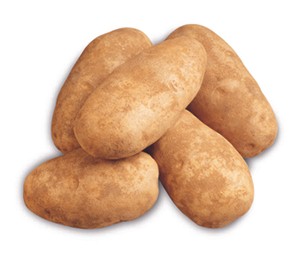 Baking.
Usually called Russets, they’re higher in starch, so they have a drier texture when cooked. They make fluffy mashed potatoes.
Baking.
Usually called Russets, they’re higher in starch, so they have a drier texture when cooked. They make fluffy mashed potatoes.
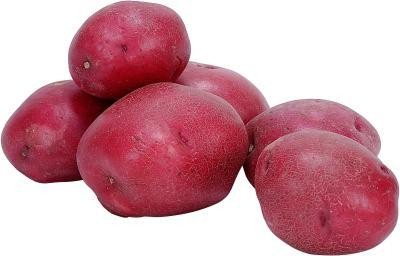 Boiling.
Usually red skinned, these are sometimes called new potatoes. They have a waxier texture and don’t absorb liquid well. They aren’t recommended for mashing.
But if you do use them, leave the skins on for more texture, and don’t over-beat them or they’ll become gluey.
Boiling.
Usually red skinned, these are sometimes called new potatoes. They have a waxier texture and don’t absorb liquid well. They aren’t recommended for mashing.
But if you do use them, leave the skins on for more texture, and don’t over-beat them or they’ll become gluey.
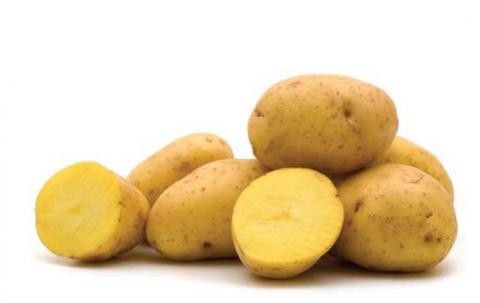 All-purpose.
The best known are Yukon Golds. They have a texture between the other two and a flavor that’s complemented with butter. They make creamy mashed potatoes.
For the best of both potato worlds, combine Yukon Golds with a Russet: Creaminess and fluffiness is the result.
All-purpose.
The best known are Yukon Golds. They have a texture between the other two and a flavor that’s complemented with butter. They make creamy mashed potatoes.
For the best of both potato worlds, combine Yukon Golds with a Russet: Creaminess and fluffiness is the result.
Super. Now that we know which spuds make the best mashers, what tools should we use?
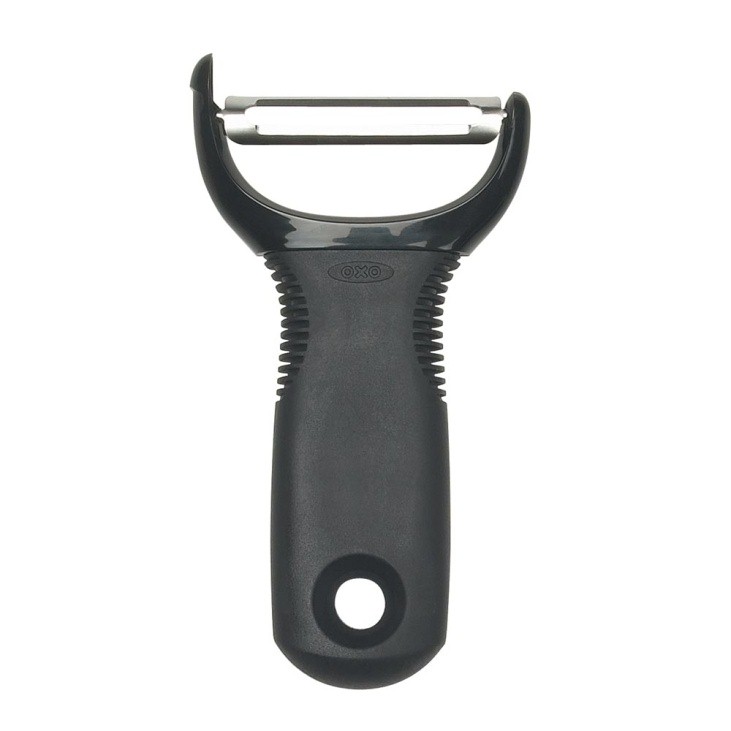 Peeler.
Y- or U-shaped peelers are great for long potatoes, like russets and sweet potatoes. Shorter straight-blade peelers are great for round potatoes, and the
rounded tipped blade does the best job of lifting out “eyes.”
Peeler.
Y- or U-shaped peelers are great for long potatoes, like russets and sweet potatoes. Shorter straight-blade peelers are great for round potatoes, and the
rounded tipped blade does the best job of lifting out “eyes.”
Masher.
A true potato masher, with a flat bottom attached to a handle, is great for mashing potatoes in the pot, especially if you don’t mind (or prefer) a few
lumps. (A sturdy whisk with heavy tines can double as a masher.)
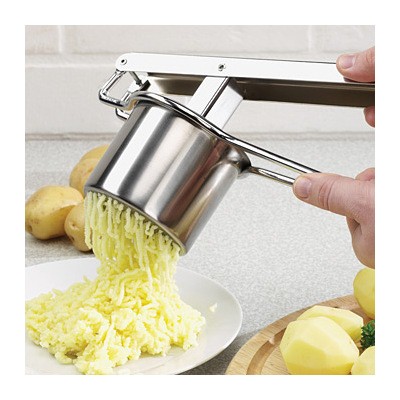 Ricer.
It’s usually round with two handles for pressing together and a grid with holes. You squeeze out long strands of potato and then whisk in milk and butter,
making really smooth mashed potatoes. (A food mill works, too, but has more parts to clean.)
Ricer.
It’s usually round with two handles for pressing together and a grid with holes. You squeeze out long strands of potato and then whisk in milk and butter,
making really smooth mashed potatoes. (A food mill works, too, but has more parts to clean.)
Electric mixer. It can overbeat potatoes, making them gluey; save it for big batches. Never use a food processor: The blades cut across the molecules, releasing too much starch and giving mashed potatoes the texture and flavor of library paste.
Beater. After mashing or pressing potatoes, liquid and butter is added. A whisk is best, although a wooden spoon with a comfortable handle works.
Next, the process for basic mashed potatoes. How it’s done is as important as what you add. Here’s how Dr. Potato from the Idaho Potato Council does it:
- Peel potatoes; drop them into a large pot of cold water. Cut large potatoes into chunks, keeping the pieces large. After all potatoes are peeled, pour off the starchy water and add fresh cold water and 1 tablespoon salt.
- Place pot on the stove over high heat. Bring to a boil, then reduce heat to medium to maintain a brisk simmer. When potatoes boil, the starch sets, making them fall apart and become too watery. It’s better to cook them longer at a lower temperature.
- Cook for 30 - 40 minutes. To be sure they’re done: Stick a sharp knife tip into a few potatoes. If you can slide in the knife but the potato still clings to the blade, they aren’t done.
- Drain potatoes; return them to the empty pot on the still-hot burner. Shake the pot a few times to help remaining water evaporate. Mash them roughly with a masher or squeeze through a ricer. Whisk in remaining ingredients with a sturdy whisk or wooden spoon.
And is butter or milk added first? The order makes a difference. When you beat in butter before milk, the fat coats the molecules so they can’t absorb as much liquid. That creates fluffier mashed potatoes. If you beat in the milk before the butter, the molecules absorb more milk, giving creamier potatoe. Neither is better, it’s just a question of which you prefer.
Finally, what ELSE can you add?
- Buttermilk for creaminess with less fat than whole milk or cream (although it is higher in fat than nonfat milk). The flavor is slightly tangy, but not so strong that buttermilk haters will object.
- Sour cream and cream cheese. Plain mashed potatoes can have an off-flavor when reheated. Sour cream and cream cheese creates a richer mixture allowing reheating without changing the texture or flavor.
- Cheese. Cheddar, brie, Gruyere, Swiss, etc.
- Mustard. Dijon mustard in mashed potatoes is magic.
- Roasted garlic.
- Bacon.
- Cooked cabbage: Potatoes and cabbage is a classic.
-
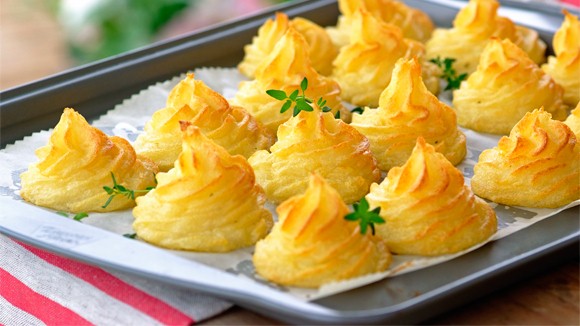 Egg yolks. For fancy Duchess potatoes, beat yolks into cold potatoes, then pipe them onto a baking sheet and bake until they’re browned in spots.
Egg yolks. For fancy Duchess potatoes, beat yolks into cold potatoes, then pipe them onto a baking sheet and bake until they’re browned in spots.
- www.shockinglydelicious.com
- www.livestrong.com
- www.ambafarm.com
- www.oxo.com
- www.shop.express.co.uk
- www.whatsfordinner.co.za
 Alice Osborne
Alice Osborne
Weekly Newsletter Contributor since 2006
Email the author! alice@dvo.com
